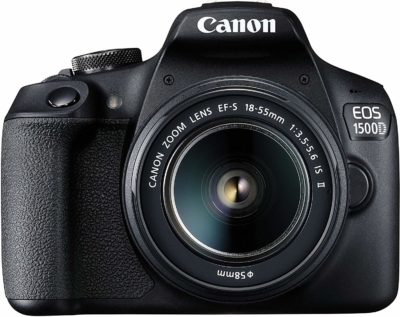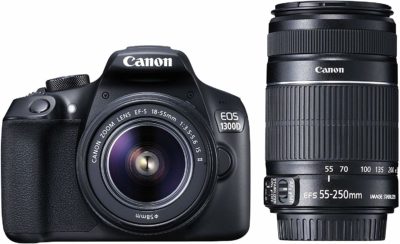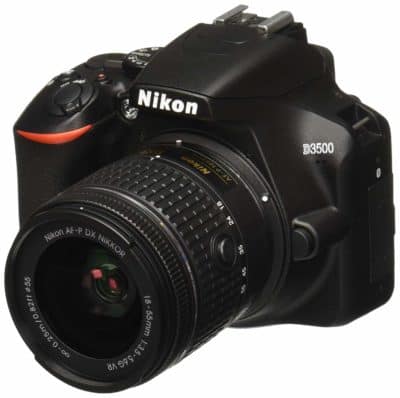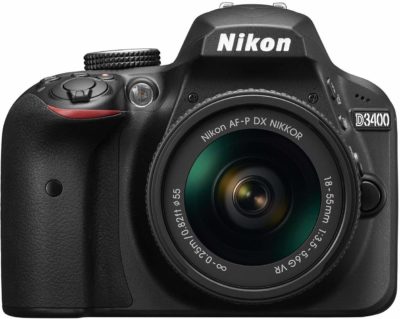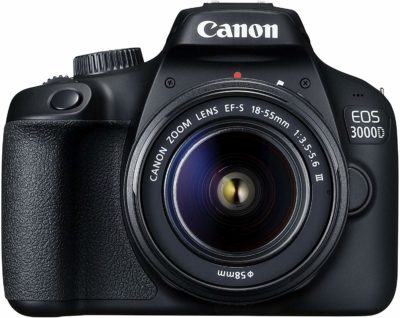Best Budget DSLR Cameras
While smartphone cameras are getting advanced day by day, the stunning image quality produced by professional cameras are still far-reaching. DSLR cameras are a good compromise between the camera-phones and professional cameras.
DSLR cameras also act as a good stepping stone to professional shooting. For people who like casual photography, these cameras allow them to shoot better images. They are quite affordable and can be picked up by anyone as they are easy to use.
We’ll explore all the key areas involved such as what is DSLR? working of DSLR and its benefits. These include the functional mechanism, key factors to consider before any decisions are made, Our Top 5 recommended products and some of the best models on today’s market along with a few FAQs
Top 5 Best DSLR Cameras in India
| Product (Best Brands) | Best Price |
|---|---|
Impeccable Optical system, durable design | |
Powerful lens, prism and highly convenient | |
Durable, powerful lens and sensor | |
Highly advanced system, solid construction | |
Reliable, advanced optical system |
What’s a DSLR Camera, and how does it work?
DSLR is an abbreviation for “Digital Single Lens Reflex.” In layman’s terms, DSLR cameras combine digital and analog light processing mechanisms to exploit the advantages that come with both modes of operation.
Unlike mirrorless cameras, DSLRs incorporate a mirror that reflects light from the lens towards an eyepiece, known as the Optical Viewfinder. This represents the analog component of the camera.
The digital component consists of an image sensor, which reacts to the converging light rays from the lens. This reaction is further processed as a digital image which is fed to the optical viewfinder.
Mostly, DSLRs are a digitized version of the primary Single Lens Reflex Camera mechanism which we’ve discussed at great length in our best mirrorless cameras guide.
How a DSLR Camera Works
Let us look at the main components of the DSLR Camera before we get into the mechanics.
- Lens: Converges the incoming light rays to one point to form an image.
- Mirror: It sits between the shutter and lens. Reflects the light rays from the lens towards the Pentaprism.
- Shutter: Controls the amount of light reaching the image sensor through an opening and closing mechanism.
- Image Sensor: Detects the image and expresses it as electronic/digital data.
- Pentaprism: Reflects light from the mirror to the Optical Viewfinder.
- Optical Viewfinder: An eyepiece for viewing the image and other relevant parameters.
A look into the optical viewfinder gives you an exact image of whatever you intend to capture. Light from an object or scene you are trying to capture strikes the lens and gets redirected (converged) towards the mirror, which is oriented at a 45-degree angle at a small distance behind the lens.
The mirror reflects the light rays in a vertical direction towards another component known as the Pentaprism. The Pentaprism then redirects the rays on a horizontal path towards the Optical Viewfinder where the image is presented to your eye.
But what happens when you hit the capture button?
Once you hit the capture button, it triggers a series of mechanisms which shift the mirror from the light beam’s pathway and open the shutter to let light through to the image sensor.
The shutter stays open for a specific period to allow the image sensor adequate time to record the scene. After this window, the shutter then closes, and the mirror gets back to its original position.
The reaction from the sensor is then converted into digital information by the camera’s processor and stored as digital data in a storage device. Obviously, this process takes place at lightning speed, with some cameras being able to operate as fast as 11 times per second.
Key benefits of using DSLR Cameras
Enhanced Image Quality
DSLRs tend to come with enhanced image sensors, higher pixel ratings, which translate into improved image quality. In addition to the two parameters, they also typically come in with a wide range features which give them an extra edge over the traditional SLR camera.
Adaptability
By allowing the user to change lenses, the DSLR camera provides a highly adaptable system which can be used in a wide range of situations.
While the basic point-and-shoot camera can afford significant quality levels, a DSLR can accommodate a wide range of lenses with varying focal lengths, thus making it capable of achieving exceptional qualities.
When this is coupled with a range of accessories, the camera can simply be turned into an exceptionally versatile optical device.
Efficiency
When it comes to image processing speed, start-up and focusing, DSLR tends to come out as one of the fastest devices on the market.
Optical Viewfinder
Due to the optical mirror and Pentaprism apparatus, DSLRs ensure that the image is a replica of the real object. This is critical for more effective fine-tuning of the necessary parameters.
More comprehensive manual Controls
While other types such as point-and-shoot cameras incorporate the manual mode, DSLRs come with a more comprehensive set of manual controls.
This allows the photographer a more comprehensive way of tailoring the settings to specific needs. If you are an experienced photographer, this proves a valuable tool to have at your fingertips.
Great Optics
Though there is a huge difference when it comes to the lenses among DSLRs. The type of lenses on DSLRs tend to be superior to the ones you can find on other types such as point-and-shoot cameras.
What to look for in a DSLR camera
Due to the overwhelming diversity of models on the market, most buyers have to deal with the question: what exactly should I look for in a DSLR camera?
The answer isn’t usually that easy, as there are myriad factors that need to be considered carefully in light of individual needs.
The overall cost
This is obviously the best place to start as it affects the kind of design and features which will be available to you. As you would expect, DSLRs fall within the lower mid and high-end price categories.
The range of functional features also expand as you go up the ladder, with professional models offering the most comprehensive feature sets. The key here is in defining what you want to use the camera for.
If you look at yourself as an amateur, the mid and lower price range is most likely to offer something which is quite suited to your needs.
If you are considering to go pro, or you are an already established professional who is looking to upgrade to something more advanced, the upper mid-range and high-price range should have a good fit in-store.
Lenses
It’s always prudent to consider the cost of replacing lenses as the chances are that you may need to upgrade or simply replace the existing one in the future. This especially applies to professional photographers who might need several lenses to adapt the camera to specific needs.
Batteries
Almost all products come in with a set of batteries. However, it’s great to take your time and look at the cost of replacement in light of the camera’s efficiency in terms of energy consumption.
Camera Bag
Though most models come with a bag, some may not be as durable. Therefore you may need to consider the probable cost of a high-quality bag.
UV filters
UV filters help keep out the harmful ray from the sun. This prevents over exposure in your photos and also protects your lenses.
Size
If you don’t mind carrying some weight or using a tripod, size shouldn’t be much of an influential factor. However, if you are looking to get involved in on-the-go photography, it’s great to consider the lightest model, which offers the required quality.
Features
Now let’s take a look at some of the common DSLR features which have proven valuable to a wide range of users.
Mode dial
Just like other types of digital cameras, DSLRs incorporate a mode dial (or PASM dial), which is used to access a variety of automatic scene-mode settings. Some of the standard settings include shutter priority, program, aperture priority, fully manual mode.
Scene modes vary between cameras and are not customizable in most models. Good examples include silhouette, portrait, landscape, and many others. However, it is usually possible to achieve these settings manually by working in different settings.
Since professionals tend to be masters at manual calibration, most professional DSLR models don’t come with automatic scene-modes.
Dust reduction mechanisms
There are a variety of mechanisms used to prevent dust from accumulating in the camera’s chamber. Some models use the dust cover filter, which is mounted behind the lens to prevent the dust from reaching the inner, sensitive parts of the camera.
Other models such as some of the earliest DSLR models from the Olympus brand, incorporate a cleaning mechanism which relies on a built-in dust sensor.
Other models upgrade this mechanism by adding a vibrating sensor which operates at ultrasonic frequencies to remove the dust.
Interchangeable lenses
DSLR cameras are known for allowing the user to change lenses, thus having an extra edge in terms of making the camera adaptable to specific needs. This especially comes in handy for people who require several specialized lenses to handle different photographic needs.
In most cases, most lens mounts are built to accommodate a specific range of interchangeable lenses, which are usually products of the same manufacturer. For instance, an Olympus camera’ body might only be compatible with a range of interchangeable lens from the same brand.
There is also a good number of lens manufacturers who specializes in producing interchangeable lenses which can work on a wide variety of brands. Additionally, there are also lens adapters which allow you to use a specific lens on a different lens mount.
High Definition video capture
By the end of 2008, most manufacturers of DSLR cameras started producing cameras with movie-mode functionality; enabling users to record top definition videos. DSLRs which incorporate this functionality are commonly known as HDSLRs.
Video functionality in HDSLR cameras has evolved with time as manufacturers continue to produce more advanced models with greater resolutions and other features such as enhanced autofocus, exposure controls, and production of advanced file formats.
Live preview
The first DSLR cameras couldn’t display the image in the optical Viewfinder on an LCD: a functionality commonly known as Live preview.
This comes in handy in circumstances where it’s impractical to use the Optical Viewfinder, such as in underwater viewing where the device is usually enclosed in a waterproof container.
Larger sensor sizes and better image quality
DSLR cameras’ image sensors come in a variety of sizes. The largest sizes are found in “medium format” cameras. Due to the high costs associated with t0e manufacturing process, these cameras tend to come with high-end price tags.
“Full-frame” cameras incorporate image sensors with an identical size to the 35mm standard image film. The majority of modern DSLRs come with an APS-C sized sensor which measures at around 22×15mm, which is about 40% of the total size of a full-frame sensor.
Other sizes in popular brands range tend to fall somewhere between 26% and 61% of the full-frame size.
The sensor’s capacity can also be described in terms of resolution, which is usually indicated by a megapixel rating. Normally, the larger the size, the higher the megapixel rating. However, a higher rate does not necessarily imply higher quality.
Depth-of-field control
As you might be aware, lenses have their appropriate range of aperture sizes, and those used in DSLRs tend to have a wider range of aperture sizes. These can fall anywhere between f/0.9 and f/32. Those with smaller sensors tend to fall within the f/2.8 and f/5.6 range.
To augment the range of exposure, some cameras with smaller sensors incorporate a filter pack into the aperture. Normally, apertures on cameras with small sensors tend to provide greater depth of field than DSLRs at the angle of view.
The enhanced angle of view
The camera’s angle of view is largely dictated by its focal length and the size of the image sensor. For instance, given a lens with a particular focal length, a DSLR with a (36×24mm) sensor affords a smaller angle of view than a DSLR with a full-frame sensor.
However, full-frame sensor cameras are quite scarce, largely due to the inflated manufacturing costs, which also translate to inflated market price tags.
Other features
Other models have gone the extra mile to incorporate some high tech features which may be relevant in some professional circles or to those who are simply looking to get something that offers much more.
Another exciting feature seen in some recent models is the ability to carry out 3D imaging. For instance, some models produced by Sony in recent years allow for the Panorama mode 3D mode which enables it to produce 3D images which can be viewed on 3D-enabled TV sets.
6 Best DSLR Cameras
1. Canon EOS 1500D – Impeccable Optical system, durable design
The first slot on the list goes to one of the most popular devices among ardent photographers known as the Canon 1500D.
It has an impeccable feature set which shows all the signs of ultra-efficiency and design craftsmanship. Let’s take a look at the key features.
- Image sensor- CMOS sensor, sensor size: approx. 22.3 x 14.9mm.
- Recording media- SD, SDHC, and SDXC memory cards
- Effective pixels- 24.1 megapixels.
- Viewfinder type- Eye-level pentamirror.
- Coverage- 95% for both vertical and horizontal, Eyepoint: About 21mm.
- Autofocus – AF point: 9-points (All AF points support f/5.6. Cross-type AF with center AF point.), Brightness range for auto-focusing: EV 0 – 18 (Center AF point).
- Metering modes – Evaluative, partial, and center-weighted.
- Highest ISO rating – Up to 6400, manually, expandable to 12800.
- Shutter speed – 1/4000 to 30 sec.
- Movie Shooting – Recording format: MOV, MPEG-4 AVC, with variable bit rate.
- Connectivity – WiFi IEEE 802.11 b/g/n/a/ac, USB Type C, HDMI.
- Battery – LP-E10 battery pack.
- Enhanced optics: It features a powerful mirror system for greater quality visuals.
- Durable construction.
- Versatile connectivity profile.
- Efficient focusing system.
- It has enhanced video resolution.
- Inflated price tag.
2. Canon Eos 1300D – Powerful lens, prism and highly convenient
The Canon EOS 1300D has proven a great camera for everyone who is willing to spend a little more on a highly advanced but ultra-portable device. It is also known for its solid and stylish build.
- Sensor – APS-C CMOS Sensor
- Effective pixels: 18 Megapixels
- Viewfinder frame coverage: 95% with 0.80× magnification
- Sensitivity – ISO: 100-6400.
- Image Processor – DIGIC 4+
- Focus points – 9 autofocus points.
- Video Resolution – Full HD (1920×1280)
- Connectivity – WiFi IEEE 802.11 b/g/n/a/ac, NFC and Bluetooth.
- Lens – Mount: EF-S mount, Compatible lenses: EF and EF-S lenses.
- Shutter speed – 3.0 frames per second of continuous shooting
- LCD screen – TFT 3.0″ color screen in 4:3 ratio.
- It comes with one of the most powerful sensors for enhanced image quality.
- Solid and reliable construction.
- It comes with great comfortable size and conveniently placed controls.
- It proves versatile gadgets as it can work with a wide variety of lenses.
- Relatively high price tag.
3. Nikon D3500 – Durable, powerful lens and sensor
The Nikon D3500 reminds us that the Nikon brand is a great all-rounder with a strong presence in all categories and types of cameras. Let’s plunge into the details.
- Sensor – CMOS
- Effective Pixels – 24.2 million Megapixels.
- Sensor Size – 23.5 mm x 15.6 mm.
- Image Sensor Format – DX.
- Storage Media – SD, SDHC, and SDXC.
- Shutter speed – 5 frames per second.
- ISO Sensitivity – 100 – 25,600.
- Monitor Size – 3.0 inches diagonal.
- Monitor Type – Wide Viewing Angle TFT-LCD.
- File Format – Compressed RAW, JPEG, RWA+JPEG.
- Viewfinder- Viewfinder type.
- Eye-level pentamirror single-lens reflex.
- Lens Compatibility: type E and G AF-S lenses.
- Shutter – Shutter Speed: 1/4000 to 30 sec.
- Release Modes: Continuous, quite, self-timer, and single frame.
- Top Continuous Shooting Speed at Full Resolution: 5 frames per second.
- Connectivity – Bluetooth 4.1, USB, HDMI.
- Power features – EN-EL14a rechargeable Li-ion battery.
- Battery Life: 1,550 shots per full recharge.
- Powerful lens and mirror system.
- It features one of the most advanced focusing systems.
- Solid construction.
- Reasonable price tag.
- Lower shutter speed.
4. Nikon D3400 – Highly advanced system, solid construction
If you are willing to sacrifice money for a DSLR camera which affords most amenities needed in professional cameras, this great device from Nikon should be on your shortlist. Let’s have a look into the details.
- Image sensor – CMOS.
- Effective Pixels – 24.2 million Megapixels.
- Sensor size – 23.5 mm x 15.6 mm.
- Storage media – SD, SDHC, and SDXC.
- Top continuous shooting speed at full resolution – 5 frames per second.
- ISO Sensitivity – 100 – 25,600.
- Monitor Size – 3.0 inches diagonal.
- File Format – Still Images: Compressed RAW, JPEG, RWA+JPEG.
- Viewfinder type – Eye-level pentamirror single-lens reflex.
- Lens Compatibility – type E and G AF-S lenses
- Fastest Shutter Speed: 1/4000 sec.
- Top continuous shooting speed at full resolution: 5 frames per second.
- Connectivity – Bluetooth 4.1, USB, HDMI.
- Battery Life: 1,200 shots per full recharge.
- High-end optical system.
- Enhanced focusing.
- It features durable construction.
- Enhanced connectivity profile.
- Lower battery life than some devices with the lower price tag.
- Relatively pricey within the lower category.
5. Canon EOS 3000D – Reliable, advanced optical system
This is simply another masterpiece from the world-renowned brand, as demonstrated by an impeccable track record and a carefully designed system. It is known for its reliability, user-friendliness, and efficiency. Let’s take a look.
- Weight and dimensions – It measures 13.8 x 22.4 x 16.8 cm and 1.54kg in terms of size and weight.
- Image sensor – APS-C-size CMOS.
- Effective Pixels – 18 megapixels.
- Image processor – DIGIC 6 with iSAPS technology.
- Compatible lens: Canon EF-S lenses.
- Exposure Control – Sensitivity: AUTO ISO: 100-6400.
- File types – Still images: RAW, JPEG, Video: MP4, MPEG4-AVC, and MPEG-4 AAC-LC.
- Interface – USB, HDMI, A/V input-output, Wifi (IEEE 802.11 b/g/n)
- Storage Media: SD, SDHC, SDXC
- Versatile: It deliver good image quality with both still images and videos.
- It has a durable construction.
- Fairly enhanced battery life.
- It caters for all the external connectivity needs.
- Slow live view focusing.
Frequently Asked Questions
1. What’s the Best DSLR camera?
Determining the best model comes down to knowing your individual needs and tailoring your choice to those needs. This implies that there is no necessarily single best for all though some models are quite advanced. Though, Nikon DSLRs and Canon DSLRs are the best amongst others.
2. Which key factors influence the quality of the image?
The primary factors include lens, sensors, and the quality of construction between the lens and the optical viewfinder.
3. What’s the difference between a DSLR and SLR camera?
The key difference is that SLRs eliminate the digital components to adopt a completely analog system.
Conclusion
Having gone through the buying guide, features, tips and FAQs, we have no doubt that you will be able to choose a camera that best suits your needs. While all cameras in this list are worthy of being the perfect choice, we highly recommend the Canon EOS 1500D





